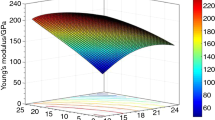Abstract
In this paper a thick hollow cylinder with finite length made of two dimensional functionally graded material (2D-FGM) subjected to transient thermal boundary conditions is considered. The volume fraction distribution of materials, geometry and thermal boundary conditions are assumed to be axisymmetric but not uniform along the axial direction. The finite element method with graded material properties within each element is used to model the structure and the Crank–Nicolson finite difference method is implemented to solve time dependent equations of the heat transfer problem. Two-dimensional heat conduction in the cylinder is considered and variation of temperature with time as well as temperature distribution through the cylinder are investigated. Effects of variation of material distribution in two radial and axial directions on the temperature distribution and time response are studied. The achieved results show that using two-dimensional FGM leads to a more flexible design so that transient temperature, maximum amplitude and uniformity of temperature distributions can be modified to achieve required specifications by selecting a suitable material distribution profile in two directions.















Similar content being viewed by others
Abbreviations
- c(r, z):
-
Heat capacity of functionally graded material
- c 0 :
-
Constant value
- c1, c2:
-
First ceramic and second ceramic
- h i , h o , h L , h T :
-
Convection coefficients at inner, outer, lower and upper surfaces
- k r (r, z), k z (r, z):
-
Thermal conductivity in the radial and axial directions
- [k 1]e, [k 2]e, [k 3]e :
-
Characteristic matrices of elements
- [K 3], [K]:
-
Global characteristic matrices
- [N(r, z)]:
-
Matrix of linear interpolation functions
- n r , n z :
-
Radial and axial power law exponents
- m1, m2:
-
First metal and second metal
- {q}e :
-
Nodal temperature vector of element
- {Q}:
-
Global nodal temperature
- r i , r o :
-
Inner and outer radii
- T c :
-
Constant value
- T ∞ :
-
Surrounding temperature
- \( V_{{c_{1} }} \), \( V_{{c_{2} }} \), \( V_{{m_{1} }} \), \( V_{{m_{2} }} \):
-
Volume fractions of basic materials
- ρ(r, z):
-
Mass density of functionally graded material
References
Koizumi M (1993) The concept of FGM. Ceram Trans Funct Graded Mater 34:3–10
Awaji H (2001) Temperature and stress distributions in a plate of functionally graded materials. Fourth international congress on thermal stresses, June 8–11, Osaka, Japan
Jin ZH (2002) An asymptotic solution of temperature field in a strip of a functionally graded material. Int Common Heat Mass Transf 29:887–895
Jabbari M, Sohrabpour S, Eslami MR (2002) Mechanical and thermal stresses in a functionally graded hollow cylinder due to radially symmetric loads. Int J Press Vessel Pip 79:493–497
Jabbari M, Sohrabpour S, Eslami MR (2003) General solution for mechanical and thermal stresses in a functionally graded hollow cylinder due to nonaxisymmetric steady-state loads. ASME J Appl Mech 70:111–118
Sladek J, Sladek V, Zhang CH (2003) Transient heat conduction analysis in functionally graded materials by the meshless local boundary integral equation method. Comput Mater Sci 28:494–504
Tarn JQ, Wang YM (2004) End effects of heat conduction in circular cylinders of functionally graded materials and laminated composites. Int J Heat Mass Transf 47:5741–5747
Chen B, Tong L (2004) Sensitivity analysis of heat conduction for functionally graded materials. Mater Des 25:663–672
Wang BL, Mai YW, Zhang XH (2004) Thermal shock resistance of functionally graded materials. Acta Mater 52:4961–4972
Wang BL, Tian ZH (2005) Application of finite element–finite difference method to the determination of transient temperature field in functionally graded materials. Finite Elements Anal Des 41:335–349
Hosseini M, Akhlaghi M, Shakeri M (2007) Transient heat conduction in functionally graded thick hollow cylinders by analytical method. Heat Mass Transf. doi: 10.1007/s00231-006-0158
Abudi J, Pindera MJ (1996) Thermoelastic theory for the response of materials functionally graded in two directions. Int J Solid Struct 33:931–966
Cho JR, Ha DY (2002) Optimal tailoring of 2D volume-fraction distributions for heat-resisting functionally graded materials using FDM. Comput Method Appl Mech Eng 191:3195–3211
Hedia HS, Midany T, Shabara MAN, Fouda N (2005) Development of cementless metal-backed acetabular cup prosthesis using functionally graded material. Int J Mech Mater Des 2:259–267
Nemat-Alla M (2003) Reduction of thermal stresses by developing two dimensional functionally graded materials. Int J Solids Struct 40:7339–7356
Santare MH, Lambros J (2000) Use of a graded finite element to model the behavior of non-homogeneous materials. J Appl Mech 67:819–822
Gasik MM (1998) Micromechanical modelling of functionally graded materials. Comput Mater Sci 13:42–55
Cho JR, Ha DY (2001) Averaging and finite-element discretization approaches in the numerical analysis of functionally graded materials. Mat Sci Eng A302:187–196
Zienkiewicz OC, Taylor RL (2000) The finite element method, 5th edn. VII: Solid mechanics
Stasa FL (1985) Applied finite element analysis for engineers. CBS Publishing, Tokyo
Shao ZS (2005) Mechanical and thermal stresses of a functionally graded circular hollow cylinder with finite length. Int J Press Vessel Pip 82:155–163
Goupee AJ, Vel SS (2006) Two-dimensional optimization of material composition of functionally graded materials using meshless analyses and a genetic algorithm. Comput Methods Appl Mech Eng 195:5926–5948
Author information
Authors and Affiliations
Corresponding author
Appendix
Appendix
The matrix of linear interpolation functions is
where subscripts i, j, k are related to three nodes of each element. And its components are
where the constants a, b and c are defined in terms of the nodal coordinates as:
And A is the area of the element given by
Vector of nodal temperature (degrees of freedom) is
Rights and permissions
About this article
Cite this article
Asgari, M., Akhlaghi, M. Transient heat conduction in two-dimensional functionally graded hollow cylinder with finite length. Heat Mass Transfer 45, 1383–1392 (2009). https://doi.org/10.1007/s00231-009-0515-8
Received:
Accepted:
Published:
Issue Date:
DOI: https://doi.org/10.1007/s00231-009-0515-8



